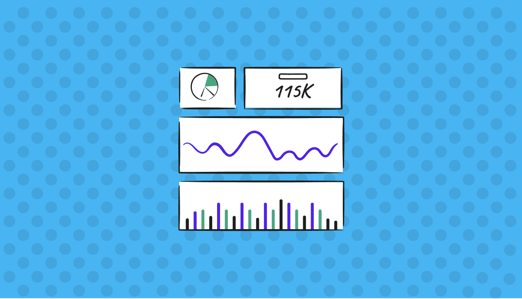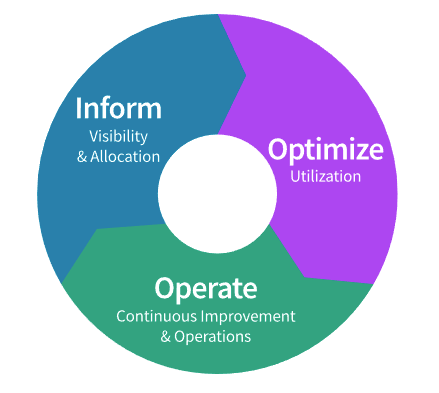
What is FinOps?
FinOps is a new operating model for the cloud, bringing financial accountability to your cloud spending. Using FinOps, your engineering and finance teams, business stakeholders, and executives will share the same language and processes, allowing you to manage your cloud costs better and deliver business features faster.
FinOps is a cultural practice that increases collaboration between teams and helps enterprises achieve maximum business value. It is an evolving discipline that helps companies manage their cloud financials collaboratively and make data-driven spending decisions.
Managing the infrastructure costs of on-premises components is irrelevant in the cloud. Resource procurement is no longer centralized, and development teams manage their resources with the guidance of a centralized finance team.
In this article, we’ll explain the core principles and lifecycle of FinOps, and why you should adopt it if you want to operate successfully in the cloud.
FinOps Principles
The FinOps Foundation offers several guidelines to help your organization adopt a successful FinOps practice. To implement cost governance and accountability, try these approaches:
Collaborate Across Teams
FinOps may require a cultural change in your organization, as teams will no longer work in silos. For example, your finance team will learn to define cost metrics and provide centralized governance for operating in the cloud. At the same time, development teams will start to consider cost as a new efficiency metric and incorporate it as a non-functional requirement while delivering business features. FinOps increases collaboration between teams and can help your organization lay a solid foundation for processes around cloud financial management.
Make Decisions Based on the Cloud’s Business Value
The cloud provides many benefits to developers and helps them enhance the delivery of their business features. It allows teams to scale, quickly provision resources with no upfront investment, and leverage managed services. FinOps isn't just about tracking cloud costs; it’s also about making decisions that will increase the cloud’s business value.
Form a Centralized FinOps Team
You should have a centralized FinOps team that manages your cloud strategy and cost governance sets cost-efficiency expectations and educates engineering teams about best practices and standards. Leverage the expertise of your FinOps team to establish cloud cost-control guardrails and cost-tagging standards, create budgets and cost forecasts, develop tools and dashboards, and optimize organizational costs.
Take Ownership of Cloud Usage
Each team in your organization should be responsible for the cloud costs of the products/resources it owns. You must be able to track team-level expenses and have in-depth visibility into spending, which will help identify where you can better optimize costs. The developers and teams that are creating resources and building products should be held accountable for their cloud spend. They have ownership of workload-level cost efficiency, can perform rightsizing exercises, and can decommission unused resources.
Create Easily Accessible FinOps Reports
Cost reports should be available to engineering teams in real-time so they can review their cloud spending. Having visibility into cost dashboards will help teams forecast and track their products' cloud usage accurately. In addition, you should have anomaly detection in place, so that teams are immediately notified when an abnormal event occurs. This is critical to make better decisions and ensure you have a fast feedback loop.
Take Advantage of the Cloud’s Variable Cost Model
In the cloud, it is easy to provision new resources. There is no upfront cost, and you only pay for the resources you use. However, you need to be cost-conscious and ensure that you use your current resources optimally. Do this by continuously monitoring resource spend to ensure that your actual costs align with your budget forecast. To further minimize your cloud costs, follow cost optimization practices like rightsizing resources, purchasing reserved instances, and turning off resources when not in use or development/sandbox environments.
The FinOps Lifecycle
Now that we have discussed the main FinOps principles, let’s explore how to implement them efficiently. To do this, there are three distinct phases—inform, optimize, and operate—that you should continuously cycle through.

Figure 1: FinOps phases (Source: FinOps Foundation)
Inform
In this phase, teams get visibility into their cloud spending in near real-time and understand it at a granular level. Costs need to be mapped with applications and business units to be analyzed and rolled up for reporting purposes. This helps your FinOps team generate budgets and forecasts for business units.
A standardized tagging strategy is crucial for providing visibility into usage and spending. To help with cost transparency and proper chargeback, you should be able to quickly identify untagged resources and take appropriate action. Create cost dashboards and scorecards to keep engineering teams informed about spending and help them identify areas for optimization.
Optimize
Once you understand your cloud spending and cost drivers, create optimization measures and set realistic goals. You should leverage the managed services provided by your cloud vendor around cost governance and optimization. These tools can help you review your organization's costs and identify trends/usage data in an interactive interface. They also provide insights into underutilized resources so you can eliminate any resource wastage.
In addition, cost anomaly alerts can help you identify any unusual usage patterns and cost spikes. The FinOps team can then analyze the entire fleet of resources and identify areas for purchasing reserved instances, as well as create a savings plan to lower the overall long-term cost. The team can also evaluate expensive resources against similar services provided by a third party, or by other cloud vendors, for due diligence.
Operate
In this phase, your organization will implement your cost optimization plan to address the findings from the optimization phase. You should build an automated process so that cost optimization measures can be performed repeatedly. Cost reports should be regularly sent to stakeholders so that they can make timely decisions and minimize the feedback loop.
Most importantly, make sure engineering teams are trained in effective cost optimization measures and empowered to implement the recommended changes. Continuous improvement, automation, and building an effective cost-governance strategy are vital considerations in this phase.
How to Successfully Adopt FinOps
Now that you understand FinOps principles and the FinOps lifecycle, you can take the first step to adopting FinOps by gaining visibility into your cloud environments. As we discussed, the FinOps journey will require your organization to make some cultural changes and to constantly iterate through the lifecycle phases. Remember, FinOps team members do not implement any changes; rather, they provide guidance and visibility into cloud usage. On the other hand, engineering teams use that information to make infrastructure changes and optimize their cloud spending.
Finout is an emerging self-service, cloud cost-observability platform that can help your organization implement cost accountability measures. With Finout, you can integrate with cloud providers and observability platforms to combine your business metrics with costs to make better business decisions.
Reach out to the Finout team today to learn how you can quickly embrace the FinOps model.
Related FinOps content:
- Guide to Choosing the Right FinOps Tools
- Guide to FinOps Azure







